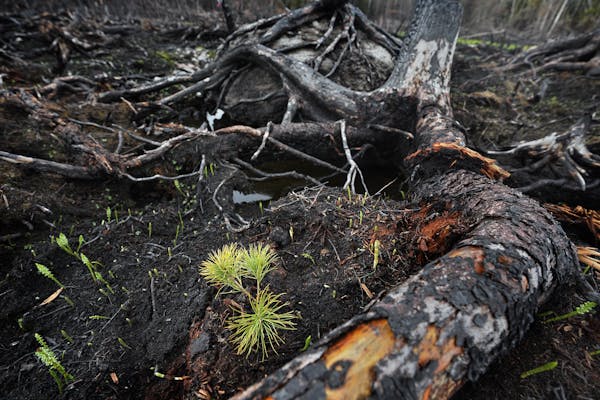A year after wildfire smoke made it dangerous to go outside in parts of Minnesota, forecasters say it's much less likely that hazardous air will choke the state again this summer.
The hazy skies that appeared in 2021 were driven by fires in Canada and, to a lesser extent, in the Superior National Forest, where the Greenwood fire blackened nearly 30,000 acres. Matt Taraldsen, a research meteorologist with the Minnesota Pollution Control Agency (MPCA), said that the deterioration in air quality caused by these fires' smoke was historic for the state.
But in a forecast released earlier this spring, the MPCA reported that "meteorologists do not expect anything near last year's conditions during 2022."
Heavy snow and rain this spring have abated the drought in northern Minnesota, according to the U.S. Drought Monitor. Those conditions continue, however, in southern Canada, which could lead to some smoke from fires drifting south, the MPCA forecast shows.
But whether there's a real impact on the air here is "very dependent on where we get fires and how long the fires persist," Taraldsen said. Blazes in the western United States may make for thin clouds of smoke high in the atmosphere, but after crossing the Rocky Mountains, lung-damaging particles rarely descend to where people in the Upper Midwest can inhale them.
Last July, by contrast, the fires to the north sent a plume of smoke over the state. Air quality readings in Brainerd and St. Cloud both briefly reached the "hazardous" category. That meant breathing outdoor air was dangerous for all people, regardless of their health.
The aggressive fire season that spurred these blazes last year in Canada is one symptom of climate change, according to Natural Resources Canada. The agency predicts that fire seasons in parts of the country will lengthen by a month by the year 2100 as the planet warms.
But Steve Marien, an eastern area predictive services meteorologist who works with federal agencies including the U.S. Forest Service, said he's optimistic about this summer's air quality.
"This year gives me hope," Marien said. "We actually got quite a bit of spring rainfall and mid-winter snow."
MPCA is also predicting there will be a few days this summer when ozone creates air quality that is unhealthy for sensitive groups, including people with asthma, upper respiratory problems and lung conditions.
The problem is worst on hot days with still air, when sunshine turns volatile organic compounds, pollutant gases near the ground, into ozone.
"Those will be the days people want to go out for walks and want to be doing things," Taraldsen said. "Those can be our most challenging days for air quality, because people will be tuned out."

Marijuana's path to legality in Minnesota: A timeline

Minnesota to close state park on Iron Range, turn it back into a mine
U.S. Steel won't get exception to pollution rules that protect wild rice, MPCA says

Taste of Minnesota to be enjoyed on the ground and in the air this year

